Content is from Kirkbride et al. 2006Kirkbride et al. 2006:
Kirkbride JH, Jr, Gunn CR, and Dallwitz MJ. 2006. Family guide for fruits and seeds, vers. 1.0. Accessed September 2020-January 2022. URL: https://nt.ars-grin.gov/seedsfruits/keys/frsdfam/index.cfm ., without modification.
Updates are forthcoming.
Crypteroniaceae A.L.P.P. de Candolle
Common name: Crypteronia Family.
Number of genera: 3 genera.
Number of species (Mabberley 1997): 11 species.
Fruits: Pistil(s) compound; 1; 1-pistillate; with carpels united. Fruit pericarpium, or anthocarpanthocarp:
simple or compound and including some tissue of non-ovarian origin (accessory tissue)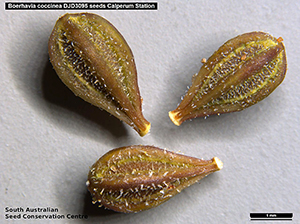 ; simple; capsulecapsule:
; simple; capsulecapsule:
a dry, dehiscent fruit derived from a compound ovary ; loculicidalloculicidal:
; loculicidalloculicidal:
type of capsular dehiscence, opening longitudinally through the locules (compare septicidal)
 capsulecapsule:
capsulecapsule:
a dry, dehiscent fruit derived from a compound ovary (of authors, but not Spjut), or ceratium capsulecapsule:
(of authors, but not Spjut), or ceratium capsulecapsule:
a dry, dehiscent fruit derived from a compound ovary (Crypteronia griffithii C. B. Clarke); capsulecapsule:
(Crypteronia griffithii C. B. Clarke); capsulecapsule:
a dry, dehiscent fruit derived from a compound ovary not inflated; capsulecapsule:
not inflated; capsulecapsule:
a dry, dehiscent fruit derived from a compound ovary without operculumoperculum:
without operculumoperculum:
a dehiscent cap (or lid) of a seed or fruit that opens during germination or dehiscence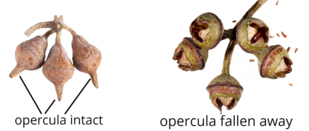 ; simple; without persistent central column; with styles(s); at apexapex:
; simple; without persistent central column; with styles(s); at apexapex:
the point farthest from the point of attachment, or the "tip" of an organ ; not within accessory organ(s), or within accessory organ(s); within receptacle; connate; persistent; more than 1 but less than 10-seeded to many-seeded; 2-seeded (-many); with 2–6-carpellate; with carpels united; with carpels remaining united at maturity; with carpels not radiating at maturity; with carpels remaining connected at stylestyle:
; not within accessory organ(s), or within accessory organ(s); within receptacle; connate; persistent; more than 1 but less than 10-seeded to many-seeded; 2-seeded (-many); with 2–6-carpellate; with carpels united; with carpels remaining united at maturity; with carpels not radiating at maturity; with carpels remaining connected at stylestyle:
in a flower, the narrow and elongated part of the pistil between the stigma and the ovary; sometimes persisting in fruit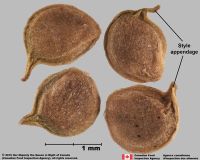 ; without sterilesterile:
; without sterilesterile:
lacking male and/or female reproductive parts; also, not producing fruit or seed
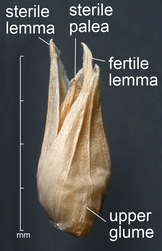 carpels; apexapex:
carpels; apexapex:
the point farthest from the point of attachment, or the "tip" of an organ not beaked; wall woodywoody:
not beaked; wall woodywoody:
texture—consisting mainly of indurate lignified tissues, characteristic of or resembling wood
, or chartaceouschartaceous:
papery, papyraceous
; dehiscentdehiscent:
(v. dehisce) splitting open at maturity to release contents (of a fruit)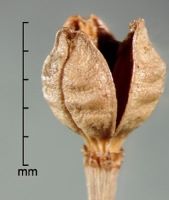 . Dehiscentdehiscent:
. Dehiscentdehiscent:
(v. dehisce) splitting open at maturity to release contents (of a fruit) unit seed(s). Dehiscentdehiscent:
unit seed(s). Dehiscentdehiscent:
(v. dehisce) splitting open at maturity to release contents (of a fruit) regularly; passively; and shedding seeds; with replumreplum:
regularly; passively; and shedding seeds; with replumreplum:
the rim, formed by the persistent placentas, and connected by a false septum in Brassicaceae fruits. The fruit valves are attached to this rim and separate from it in dehiscent fruits.
; fruit without centered partition attached to replumreplum:
the rim, formed by the persistent placentas, and connected by a false septum in Brassicaceae fruits. The fruit valves are attached to this rim and separate from it in dehiscent fruits.
. Epicarpepicarp:
outer layer of fruit wall or pericarp, if divided into layers; note here used synonymously with exocarp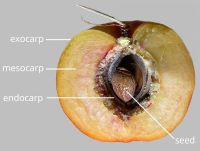 durable; glabrousglabrous:
durable; glabrousglabrous:
without hairs
, or not glabrousglabrous:
without hairs
(with hairs); hairs short; hairs not glandularglandular:
surface relief—covered with small, raised secretory glands, regular or irregularly shaped, translucent or opaque, and maybe distinctly colored ; without armature; without wing(s); without apicalapical:
; without armature; without wing(s); without apicalapical:
at or pertaining to the end of the seed or fruit distal from its point of attachment (i.e., base)
respiratory hole. Mesocarpmesocarp:
the middle layer of the pericarp, if divided into layers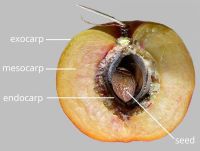 absent. Endocarpendocarp:
absent. Endocarpendocarp:
the inner layer of the pericarp, if divided into layers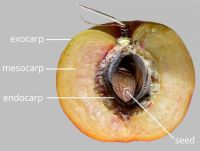 present; not separating from exocarpexocarp:
present; not separating from exocarpexocarp:
outer layer of fruit wall or pericarp, if divided into layers; note here used synonymously with epicarp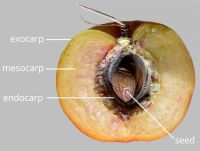 ; thin; not splitting into 1-seeded pyrenes; smooth; without wing; without operculumoperculum:
; thin; not splitting into 1-seeded pyrenes; smooth; without wing; without operculumoperculum:
a dehiscent cap (or lid) of a seed or fruit that opens during germination or dehiscence ; without secretory cavities; without mechanism for seedling escape; without grooves; without longitudinallongitudinal:
; without secretory cavities; without mechanism for seedling escape; without grooves; without longitudinallongitudinal:
of or relating to length or the lengthwise dimension
ridges. Funiculusfuniculus:
(alt. funicle) stalk connecting the ovule (later seed) to the ovary (later fruit) placenta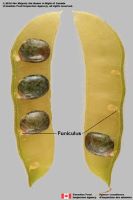 short; short without seed bearing hookswith hooks:
short; short without seed bearing hookswith hooks:
bristles or spines with curved or backwards pointing tips, or with secondary bristles along their length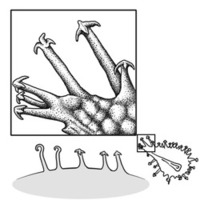 (retinacula); not persisting in fruit after seed shed.
(retinacula); not persisting in fruit after seed shed.
Seeds: Arilaril:
(broad sense) appendicular structure that wholly or partly envelops a seed and is produced from or a modification of the funicle, raphe, or outer integument; usually fleshy or pulpy, sometimes spongy or tufted-capillate, often brightly colored absent. Seed minute; less than 1 mm long; 0.5 mm long; straight, or ellipsoidellipsoid:
absent. Seed minute; less than 1 mm long; 0.5 mm long; straight, or ellipsoidellipsoid:
3D shape—elliptic
, or ovateovate:
2D shape—egg-shaped in outline, widest point is towards one end of the organ, the other end tapers gradually, attachment at or near the broad end (compare obovate, ovoid)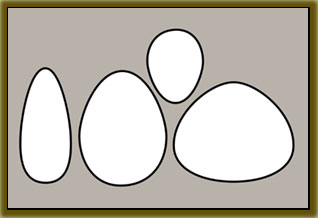 ; in transection flattened; not bowl shaped; not nutlike; without winglike beakbeak:
; in transection flattened; not bowl shaped; not nutlike; without winglike beakbeak:
a usually firm, terminal appendage, sometimes tapered ; without caudatecaudate:
; without caudatecaudate:
tapering to a long, tail-like appendage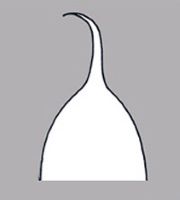 appendage(s); at maturity without food reserves; without canavanine. Sarcotestasarcotesta:
appendage(s); at maturity without food reserves; without canavanine. Sarcotestasarcotesta:
pulpy or fleshy outer layer of the seed coat, simulates aril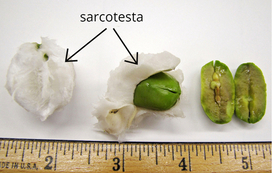 absent. Testatesta:
absent. Testatesta:
seed coat
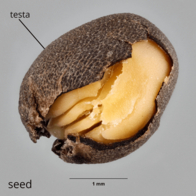 present; without fleshy or leatheryleathery:
present; without fleshy or leatheryleathery:
texture—moderately thick, tough, and very pliable
layer over hard layer; tight; without crease or line separating cotyledons from hypocotyl-radicle; without notch along margin where cotyledons from hypocotyl-radicle tip approach each other; without glands; without bristles; glabrousglabrous:
without hairs
; without wings, or with wing(s); 2-winged; with wings at both ends; with wings equally developed; with wing(s) fimbriate; with solid wing(s) similar to testatesta:
seed coat
 (membranousmembranous:
(membranousmembranous:
texture—extremely thin, pliable, and fairly tough
); without collar; without operculumoperculum:
a dehiscent cap (or lid) of a seed or fruit that opens during germination or dehiscence ; colored; monochrome; not becoming mucilaginousmucilaginous:
; colored; monochrome; not becoming mucilaginousmucilaginous:
resembling mucilage; moist and sticky
when wetted; surrounding embryo. Rapheraphe:
a ridge or seam on the seed coat, formed by the portion of the funiculus united to the ovule wall in longitudinally curved ovules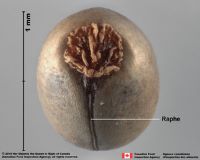 conspicuous; texture as testatesta:
conspicuous; texture as testatesta:
seed coat
 (assumed). Embryo differentiated from food reserve; well developed; 1 per seed; completely filling testatesta:
(assumed). Embryo differentiated from food reserve; well developed; 1 per seed; completely filling testatesta:
seed coat
 (no food reserve); chamber basalbasal:
(no food reserve); chamber basalbasal:
at or pertaining to the point of attachment; (of embryo) embryo occupies one end of the seed
to wing, or apicalapical:
at or pertaining to the end of the seed or fruit distal from its point of attachment (i.e., base)
to wing, or central to wings, or laterallateral:
(of embryo) embryo lies along the side of the seed, generally towards one end; of, at, or from the side; in grasses, can refer to the sides adjacent to the dorsal and ventral sides
to wing; at one end of seed not extending into a depression or cup; linearlinear:
(shape) long, narrow, and uniform in width; (of embryo) embryo is straight and much longer than wide ; straight; parallel to seed length; with cotyledons gradually connected to hypocotyl-radicle; without coleorhiza; without simmondsin; without stomata; not green; with 2 or more cotyledons. Cotyledons 2; well developed; 0.5–0.6 times length of embryo; as wide as hypocotyl-radicle; not concealing hypocotyl-radicle; not foliaceous; flat; smooth; with apicesapex:
; straight; parallel to seed length; with cotyledons gradually connected to hypocotyl-radicle; without coleorhiza; without simmondsin; without stomata; not green; with 2 or more cotyledons. Cotyledons 2; well developed; 0.5–0.6 times length of embryo; as wide as hypocotyl-radicle; not concealing hypocotyl-radicle; not foliaceous; flat; smooth; with apicesapex:
the point farthest from the point of attachment, or the "tip" of an organ entire; with margins separate; basally entire; equal in size; not punctatepunctate:
entire; with margins separate; basally entire; equal in size; not punctatepunctate:
surface relief—dotted with pits or with translucent, sunken glands or with colored dots, similar to pitted dotted. Hypocotyl-radicle well developed; straight; not thickened.
dotted. Hypocotyl-radicle well developed; straight; not thickened.
 capsulecapsule:
capsulecapsule: & valves attached & held together by persistent stylestyle:
& valves attached & held together by persistent stylestyle: . Van Beusekon-Osinga et al. (1975) loculicidalloculicidal:
. Van Beusekon-Osinga et al. (1975) loculicidalloculicidal: capsulecapsule:
capsulecapsule: . Goldberg: apparently incorrectly - fruit loculicidalloculicidal:
. Goldberg: apparently incorrectly - fruit loculicidalloculicidal: , more rarely septicidalsepticidal:
, more rarely septicidalsepticidal: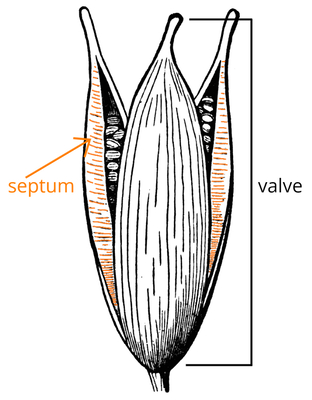 or circumscissle capsulecapsule:
or circumscissle capsulecapsule: , berryberry:
, berryberry: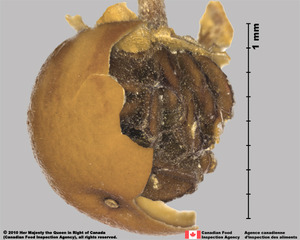 . drupedrupe:
. drupedrupe: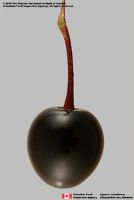 , nutnut:
, nutnut: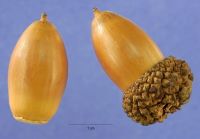 , occ. 3–4-winged. Fruit subglobse to ellipsoidellipsoid:
, occ. 3–4-winged. Fruit subglobse to ellipsoidellipsoid:Literature specific to this family: Beusekom-Osinga, R.J. van & C.F. van Beusekom. 1975. Delimitation and subdivision of the Crypteroniaceae (Myrtales). Blumea 22:255–266.
General references: Cronquist, A. 1981. An integrated system of classification of flowering plants, 1,262 p. Columbia University Press, New York, Goldberg, A. 1986 (dicots) & 1989 (monocots). Classification, evolution, and phylogeny of the familes of Dicotyledons. Smithsonian Contr. Bot. 58 for dicots (314 pp.) & 71 for monocots (74 pp.). [Goldberg's illustrations are reproduced from older publications and these should be consulted], Gunn, C.R., J.H. Wiersema, C.A. Ritchie, & J.H. Kirkbride, Jr. 1992 & amendments. Families and genera of Spermatophytes recognized by the Agricultural Research Service. Techn. Bull. U.S.D.A. 1796:1–500, Mabberley, D.J. 1987. The plant-book, 706 p. Cambridge University Press, Cambridge, and Spjut, R.W. 1994. A systematic treatment of fruit types. Mem. New York Bot. Gard. 70:1–182.